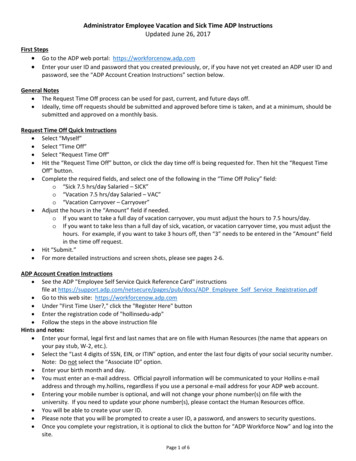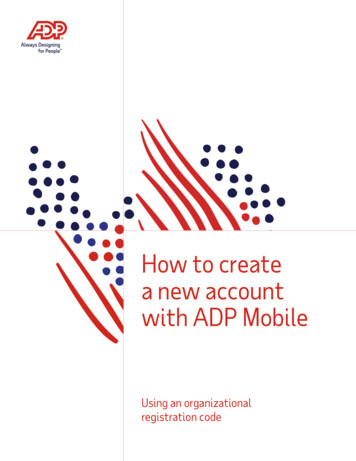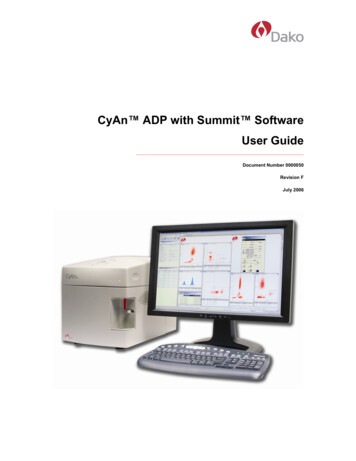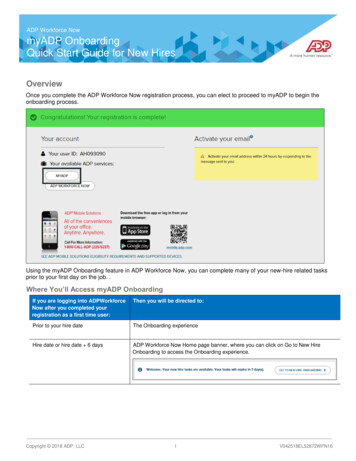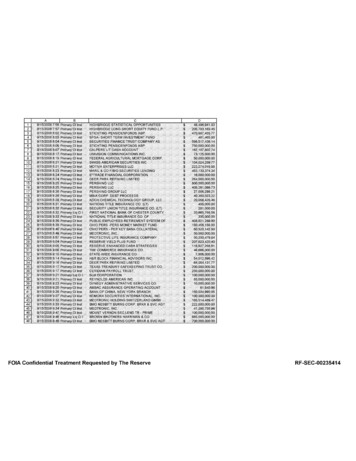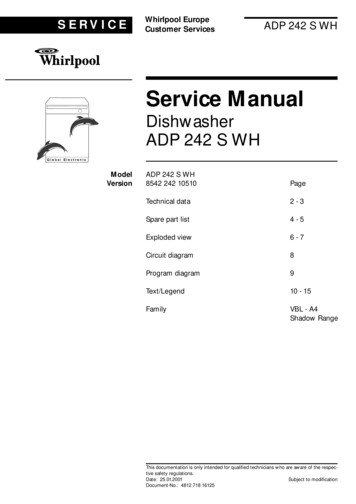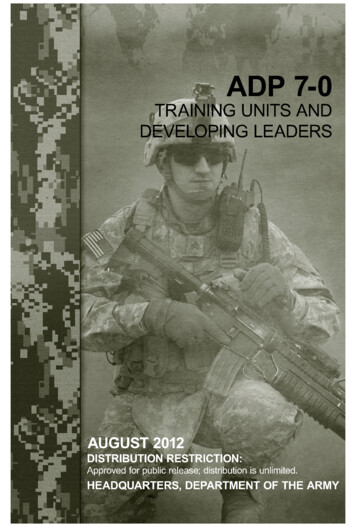
Transcription
ADP70TRAINING UNITSANDDEVELOPING RS,DEPARTMENTOFTHEARMY
This publication is available at Army Knowledge .html).
ForewordThe 2011 edition of (Field Manual) FM 7-0 reflected the Army’s unit training andleader development concepts borne from a decade of persistent combat operations.Army Doctrine Publication (ADP) 7-0, Training Units and Developing Leaders,re-establishes fundamental training and leader development concepts andprocesses for the U.S. Army. Training doctrine is again based on the Army’soperations and planning processes, now defined by ADP 3-0, Unified LandOperations, and ADP 5-0, The Operations Process.Mission command makes the commander responsible for unit readiness and leaderdevelopment. Unit commanders must be the subject matter experts. Commanderscannot delegate oversight of unit training and leader development to subordinates.The commander’s physical presence at training sends a clear message tosubordinates—unit training and leader development are the most important thingsthe unit does when it is not actively engaged in operations.Unit training and leader development are inextricably linked. Good trainingsupports leader development and good leaders develop good training programs fortheir units and subordinates. Schools provide basic skills and knowledge, but mostleader development occurs in operational assignments and throughself-development. Unit training provides a forgiving, learning environment thatallows leaders to grow from lessons learned on the job without the fear of makingirretrievable mistakes in combat that cost lives.This publication, the more expansive Army Doctrine Reference Publication(ADRP) 7-0, Training Units and Developing Leaders, and the Web-based unittraining management on the Army Training Network provide leaders with theconcepts, practices, and tools they need to manage unit training and leaderdevelopment to support unified land operations.RAYMOND T. ODIERNOGENERAL, UNITED STATES ARMYCHIEF OF STAFF
This page intentionally left blank.
*ADP 7-0 (FM 7-0)HeadquartersDepartment of the ArmyWashington, DC, 23 August 2012Army Doctrine PublicationNo. 7-0Training Units and Developing LeadersContentsPagePREFACE . iiThe Role of Training and Leader Development . 1Principles of Unit Training and Leader Development . 5Unit Training Management . 9GLOSSARY . Glossary-1REFERENCES . References-1FigureIntroduction figure. Unit training and leader developmentunderlying logic . iiiTablesTable 1-1. The Army principles of unit training .5Table 1-2. The Army’s principles of leader development .8Distribution Restriction: Approved for public release; distribution is unlimited.*This publication supersedes FM 7-0, dated 23 February 2011.i
PrefaceArmy Doctrine Publication (ADP) 7-0, Training Units and Developing Leaders, establishesthe Army’s doctrine for training units and developing leaders for unified land operations.ADP 7-0 presents overarching doctrinal guidance for training modular, expeditionaryArmy forces and developing leaders to conduct unified land operations. Conductingeffective training in units and leader development must be top priorities of senior leadersduring ARFORGEN and during deployments.The principal audience for ADP 7-0 is all leaders at all organizational levels. All leadersare trainers. Leaders include officers, warrant officers, noncommissioned officers, andthose Army civilians in leadership positions. Trainers and educators throughout the Armywill also use this publication.Commanders, staffs, and subordinates ensure their decisions and actions comply withapplicable U.S., international, and, in some cases, host-nation laws and regulations.Commanders at all levels ensure their Soldiers operate in accordance with the law of warand the rules of engagement. (See Field Manual [FM] 27-10.)ADP 7-0 uses joint terms where applicable. Terms for which ADP 7-0 is the proponent (theauthority) are indicated with an asterisk in the glossary. Definitions for which ADP 7-0 isthe proponent are printed in boldface in the text. For other doctrinal terms defined in thetext, the term is italicized and the number of the proponent publication follows thedefinition.ADP 7-0 applies to the Active Army, the Army National Guard (ARNG)/Army NationalGuard of the United States (ARNGUS), and the United States Army Reserve (USAR)unless otherwise stated.The proponent of ADP 7-0 is the United States Combined Arms Center. The preparingagencies are the Combined Arms Doctrine Directorate (CADD) and the TrainingManagement Directorate (TMD) within the Combined Arms Center for Training (CAC-T).Both CADD and CAC-T are subordinate to the U.S. Army Combined Arms Center. Sendwritten comments and recommendations on Department of the Army (DA) Form 2028(Recommended Changes to Publications and Blank Forms) to Commanding General, U.S.Army Combined Arms Center and Fort Leavenworth, ATTN: ATZL-MCK-D (ADP 7-0),300 McPherson Avenue, Fort Leavenworth, KS 66027-2337; by email il.mil; or submit an electronic DAForm 2028.iiADP 7-023 August 2012
Training Units and Developing LeadersIntroduction figure. Unit training and leader development underlying logic23 August 2012ADP 7-0iii
This page intentionally left blank.
This ADP establishes the role of training and leader development,including Army civilian leader development. It discusses training,which prepares Soldiers, Army civilians, organizations, and theirleaders to conduct unified land operations. Finally, this ADPdiscusses how Soldiers and units are trained.THE ROLE OF TRAINING AND LEADERDEVELOPMENT1. Unit training and leader development are the Army’s life-blood. Army leaderstrain units to be versatile. They develop subordinate leaders—military and Armycivilians—to be competent, confident, agile, and adaptive using the Army leaderdevelopment model. Units and leaders master individual and collective tasks requiredto execute the unit’s designed capabilities and accomplish its mission. Army forcesconduct training and education in the Army in three training domains: institutional,operational, and self-development. Army training and education methods evolve. TheArmy adopts better ways to foster learning, adapting how it trains units and developsleaders by employing innovative techniques, relevant to the learning requirements andenvironment.2. Commanders are responsible for training units and developing leaders.Commanders exercise this responsibility through formal and informal chains, assistedby other officers and noncommissioned officers, through the development andexecution of progressive, challenging, and realistic training. Commanders areresponsible for the objective, professional assessment of the results of unit training andleader development.3. Training begins in the generating force. In schools and training centers, Soldiersare introduced to Warrior Tasks and focus on developing individual skills andknowledge—the fundamentals that will help them integrate into a team to train on unitcollective tasks. Individuals return to schools from operational assignments at certainpoints to gain the skills, knowledge, and behaviors needed in their current assignmentas well as prepare them for the next duty assignment and for higher levels ofresponsibility.4. Operational assignments build on the fundamental skills, knowledge, andbehaviors developed in institutional training. Operational assignments mature this23 August 2012ADP 7-01
ADP 7-0baseline knowledge into a mission capability at the individual, crew, unit, staff, andleader level. Periodic re-engagements in institutional venues incrementally improveSoldier capabilities. Soldiers and leaders train to master both the individual and unitcollective tasks that support the unit’s mission-essential tasks. Individuals, teams,sections, and units train to standard as part of a combined arms team. Major trainingevents, combat training center exercises, and operational deployments link together asa comprehensive progressive and sequential training and leader development program,providing the experiences necessary for building ready units. Unit commanders mustallocate time during operational assignments to ensure leaders can meet theprerequisites to attend and get the most benefit from institutional training.Commanders manage the balance among unit training requirements, leader unitassignment experience, and ensuring leaders have the right institutional training andeducation opportunities.5. Army civilians support both the operating and generating forces. They fillpositions that make it possible to man, equip, resource, and train operational Armyunits. Army civilians provide the skills and continuity essential to the functioning ofArmy organizations and programs. A well-trained civilian workforce is key to missionaccomplishment. Commanders ensure the civilian workforce gets the training,education, and experience to hone its skills and prepare for future positions. Generally,Army civilians enter the Army with the skills and knowledge required for theirposition. Army civilians enhance their knowledge, skills, and abilities through thecivilian education system, functional training, self-development, and assignments.6. Self-development is as important as institutional training and operationalassignments. Self-development is a personal responsibility. Self-developmentenhances qualifications for a current position or helps prepare an individual for futurepositions. Individuals are responsible for their own professional growth and forseeking out self-development opportunities. Soldiers and civilians sustain theirindividual strengths and address gaps in their skills and knowledge. However, forself-development to be effective, all Soldiers and civilians must be completely honestwith themselves to understand both personal strengths and gaps in skills, knowledge,and behaviors—and then take the appropriate, continuing steps to enhance theircapabilities.TRAINING7. The Army trains to provide ready forces to combatant commanders worldwide.Units train in garrison and while deployed to prepare for their mission and adapt theircapabilities to any changes in an operational environment. Army forces conducttraining individually and collectively in three training domains.8. The institutional training domain is the Army’s institutional training andeducation system, which primarily includes training base centers and schools thatprovide initial training and subsequent professional military education forSoldiers, military leaders, and Army civilians. This domain includes the centers ofexcellence and schools, both inside and outside the U.S. Army Training and DoctrineCommand.2ADP 7-023 August 2012
Training Units and Developing Leaders9. The operational training domain is the training activities organizationsundertake while at home station, at maneuver combat training centers, duringjoint exercises, at mobilization centers, and while operationally deployed. Thisdomain equates to assignments in the operational Army and the generating force.10. The self-development training domain is planned, goal-oriented learning thatreinforces and expands the depth and breadth of an individual’s knowledge base,self-awareness, and situational awareness; complements institutional andoperational learning; enhances professional competence; and meets personalobjectives. Within this domain, Army leaders expect Soldiers and Army civilians tofill in their skills, knowledge, and behavior gaps from institutional training andoperational assignments.11. Individual training allows individuals to master fundamental skills. Althoughschools and units provide individual training, individuals are responsible for their ownprofessional growth and for seeking out self-development opportunities.12. Collective training integrates and synchronizes the skills learned at the individualskill level. Individual skill proficiency is the basis for collective proficiency. Trainingin units focuses on improving unit, Soldier, and leader proficiencies. Commanders andother leaders ensure unit training plans prioritize and execute collective training tomaximize the operational performance of the unit. Collective training not onlyincludes unit-level tasks and events, but also requires individual skill proficiency, andcapitalizes on multiechelon, joint, interagency, and multinational forces trainingopportunities as often as needed.13. Soldiers and Army civilians cycle between the institutional and operationaltraining domains throughout their careers. Structured, guided, and individualizedself-development programs complement the training, education, and experiencesgained in both schools and unit assignments. Documentation of individual training inall these venues is critical in maintaining awareness of individual skills.LEADER DEVELOPMENT14. The Army is committed to training, educating, and developing its leaders—officers, warrant officers, noncommissioned officers, and Army civilians—to leadunits in the complex and challenging operational environments of the twenty-firstcentury. Training, education, and experience in the schools and units develop leadersand prepare them for assignments of increased responsibility. Leader development is acontinuous and progressive process, spanning a leader's entire career.15. Competent and confident leaders are essential to unit readiness and successfuldeployments. Uniformed leaders remain technically and tactically proficient in basicSoldier skills. They master the skills, knowledge, and behaviors necessary to performsuccessfully in their assigned position; and they begin to learn the skills, knowledgeand behaviors necessary for future positions of responsibility. Civilian leaders masterthe knowledge, skills, and abilities required of their position, providing organizationswith both leadership and managerial skills.23 August 2012ADP 7-03
ADP 7-0THE ROLE OF THE COMMANDER16. Commanders are responsible for ensuring their units are capable of performingtheir missions. Commanders cannot delegate this responsibility. Commanders aredirectly responsible, and accountable, for all aspects of unit training. They understandand employ the principles of unit training and leader development. Through guidanceand direction, commanders drive the training management process. They directlyobserve and participate in the unit’s training and leader development in order to betterassess mission readiness and help their subordinates to improve. They understand thatunit training and leader development are inextricably linked—that good training canhelp develop good leaders and good leaders are the key to good unit training. Theyfocus the unit’s efforts to optimize available time, ensuring their units train the righttasks to meet mission requirements and to support the next higher commander’s intent.Commanders look for every opportunity to coach and teach subordinates as they plan,prepare, and execute training, employing the mission command philosophy. They givetheir subordinate leaders their commander’s intent and the resources—includingtime—to plan, prepare, and conduct the training necessary to develop unit proficiency.Commander involvement makes a quantitative and qualitative difference in unittraining and leader development.17. Commanders apply the operations process—plan, prepare, execute, and assess—tounit training and leader development. They drive the process by understanding,visualizing, describing, directing, leading, and assessing unit training and leaderdevelopment. The commander’s understanding of the mission determines whichessential collective tasks the unit must train on to accomplish the mission and whichskills and knowledge subordinate leaders need for the mission. Throughout theprocess, the commander constantly refines his understanding. Through visualization,commanders determine the end state—the training objectives—for unit training andleader development. Commanders describe their end state through guidance andorders. They direct training through orders and lead through their personal presence attraining events. They constantly assess the effect of training on collective taskproficiency and leader development, and the efficiency of the training conducted.18. The Army cannot afford to conduct all training in a live environment.Commanders consider the integrated training environment (known as ITE) by mixinglive, virtual, constructive, and gaming enablers as appropriate to enhance training,improve realism, and save resources where practicable. They must understand how toemploy the training aids, devices, simulators, and simulations (known as TADSS)effectively and optimally.19. Commanders exercise mission command to give subordinates latitude indetermining how to train their units to achieve the desired end state, building trust andinitiative in subordinates. However, the commander must be involved in unit trainingand leader development. The commander’s guidance, presence, and feedback arecritical to building trust in the unit and demonstrating the importance of unit trainingand leader development.20. Commanders determine the collective tasks the unit will train, limiting the numberof tasks trained to those essential to the mission. Commanders must know, teach, and4ADP 7-023 August 2012
Training Units and Developing Leadersuse Army doctrine. They assess unit proficiency in each essential task and develop aplan to achieve proficiency. As they prepare, commanders monitor activities, ensuringresources are available and the unit can execute the training event. Since only thecommander can assess the readiness of the unit, commanders must be present duringtraining event execution. They assess performance during each training event. Bybeing involved in unit training, commanders help subordinate leaders improve andensure that the right training is occurring, and it is to standard. Their presenceimproves training, readiness, confidence, and team building.PRINCIPLES OF UNIT TRAINING AND LEADERDEVELOPMENT21. Commanders apply the principles of training and principles of leader developmentin planning, preparing, executing, and assessing unit training.PRINCIPLES OF UNIT TRAINING22. Units employ effective collective training based on the Army principles of unittraining (see table 1-1). Training must be relevant, rigorous, realistic, challenging, andproperly resourced. Collective training provides the full range of experiences neededto produce agile, adaptive leaders and Soldiers, and versatile units.Table 1-1. The Army principles of unit training Commanders and other leaders are responsible for training.Noncommissioned officers train individuals, crews, and small teams.Train to standard.Train as you will fight.Train while operating.Train fundamentals first.Train to develop adaptability.Understand the operational environment.Train to sustain.Train to maintain.Conduct multiechelon and concurrent training.Commanders and Other Leaders are Responsible for Training23. Unit commanders are responsible for training and ensuring their units are capableof accomplishing their missions. Subordinate leaders have responsibility for theproficiency of their respective organizations and subordinates.23 August 2012ADP 7-05
ADP 7-0Noncommissioned Officers Train Individuals, Crews, and Small Teams24. Noncommissioned officers (NCOs) are the primary trainers of enlisted Soldiers,crews, and small teams. NCOs help officers train units. NCOs develop and conducttraining for their subordinates that supports the unit training plan, coach other NCOs,advise senior leaders, and help develop junior officers.Train to Standard25. Units always train to the standard established for each individual and collectivetask. Leaders know and enforce standards to ensure their organization meets missionrequirements. When no standard exists, the commander establishes one and the nexthigher commander approves it.Train as You Will Fight26. “Train as you will fight” means training under an expected operationalenvironment for the mission. This means establishing in training what the unit canexpect during operations to include the culture of an operational environment.Commanders and other leaders replicate cultural settings as much as possible duringtraining, using role players or actual mission partners.Train While Operating27. Training continues when units are deployed or when conducting daily operations.As units operate, they learn from formal and informal after action reviews. They trainto improve performance and address changes in tactics, techniques, and proceduresthat affect the operation.Train Fundamentals First28. Units at every echelon must master the fundamentals needed to accomplish theirmission. Fundamentals include basic soldiering, the Warrior Tasks, battle drills,marksmanship, fitness, and military occupational specialty proficiencies that supportthe capabilities of the unit. Units proficient in fundamentals are more capable ofaccomplishing higher level, more complex collective tasks that support the unit’smission-essential task list—the fundamental, doctrinal tasks that units should beprepared to execute during any assigned mission.Leaders Train to Develop Adaptability29. Effective leaders understand that change is inevitable in any operationalenvironment. The time to react to change can be short. Adaptability comes fromtraining under complex, changing conditions, with minimal information available tomake decisions.6ADP 7-023 August 2012
Training Units and Developing LeadersUnderstand The Operational Environment30. An operational environment establishes the conditions for training. The conditionsare drawn from the operational variables—known as PMESII-PT—that must bereplicated to prepare the unit for operations. The unit training management operationorder establishes the conditions that units must meet for training.Train to Sustain31. Training prepares units and individuals to be resilient. Training must prepare unitsand Soldiers for the stress of operations. Unit training plans must incorporate programsthat improve individual and collective mental and physical fitness.Train to Maintain32. Units must conduct maintenance to ensure equipment is serviceable and availablefor the conduct of training and for mission accomplishment. Maintenance training is anintegral part of the unit training plan.Conduct Multiechelon and Concurrent Training33. Multiechelon training is a training technique that allows for the simultaneoustraining of more than one echelon on different or complementary tasks. It optimizestraining time for subordinates during higher unit training events. Training multipletasks concurrently preserves valuable time while capitalizing on the opportunity totrain related tasks at the same time.PRINCIPLES OF LEADER DEVELOPMENT34. Leaders follow the principles of leader development to develop other leaders (seetable 1-2 on page 8). Schools provide leaders with enough fundamental information tohelp them contribute to unit collective capabilities on the day they arrive in the unit.However, most leader development occurs during operational assignments. Inoperational assignments, leaders learn to adapt to new situations and develop on thejob through training and education. More significantly, they develop throughchallenging, unfamiliar experiences that require them to adapt theory to reality. Theylearn through regular and as-needed feedback. They learn from their mistakes. Theylearn to take risks and experiment with non-textbook solutions to problems. They learnwhat they do not know and fill the gaps through self-development. Operationalassignments are the crucible of leader development.23 August 2012ADP 7-07
ADP 7-0Table 1-2. The Army’s principles of leader development Lead by example.Develop subordinate leaders.Create a learning environment for subordinate leaders.Train leaders in the art and science of mission command.Train to develop adaptive leaders.Train leaders to think critically and creatively.Train your leaders to know their subordinates and their families.Lead by Example35. Good leaders understand they are role models for others and reflect the desiredleader characteristics found in ADP 6-22.Develop Subordinate Leaders36. Leaders have the responsibility for developing subordinate leaders. It is one oftheir most important functions. They train subordinates to be successful tactically andtechnically and to be prepared to assume positions of greater responsibility.Create a Learning Environment for Subordinate Leaders37. Leaders establish in their units an environment that allows subordinates to trydifferent solutions to problems. Subordinates must know that they can attemptinnovative solutions to problems. Leaders establish an environment for subordinatesthat allows subordinate leaders to make honest—as opposed to repeated or careless—mistakes without prejudice.Train in the Art and Science of Mission Command38. Effective leaders conduct operations while exercising mission command(addressed in ADP 3-0 and ADP 6-0). Employing mission command in trainingencourages risk-taking, initiative, and creativity in subordinates, while staying withinthe commander’s intent.Train to Develop Adaptive Leaders39. Training must enable leaders to respond to unexpected conditions in a positive andconstructive way. They cannot train on every task for every condition. Instead, theymust excel at a few tasks and then adapt to new tasks.Train Leaders to Think Critically and Creatively40. Leaders must be able to analyze challenging problems, keeping an open mind ondifferent perspectives of problems and unconventional ways of solving problems.8ADP 7-023 August 2012
Training Units and Developing LeadersCritical thinking and creativity are not necessarily inherent; however, leaders candevelop them.Train Your Leaders to Know Their Subordinates and Their Families41. All leaders should know their subordinates at least two levels down—theirstrengths, weaknesses, and capabilities. The Army trains leaders to know and help notonly subordinates, but also their families.UNIT TRAINING MANAGEMENT42. Training is the primary focus of a unit when not deployed. It requires the samelevel of detail, intensity, and focus that a unit applies to deployed operations. Theoperations process provides a common framework for units to plan, prepare, execute,and assess training and to integrate leader development into training plans. Battalionsand higher units use the military decisionmaking process to develop unit trainingplans; companies use troop leading procedures to develop unit training plans.43. The purpose of unit training is to build and maintain ready units to conduct unifiedland operations for combatant commanders. Units build flexibility, integration,lethality, adaptability, depth, and synchronization capabilities through the mastery ofindividual and collective tasks under the conditions of the anticipated operationalenvironment. Good training gives Soldiers confidence in their abilities and the abilitiesof their leaders, forges trust, and allows the unit to adapt readily to new and differentmissions. Unit training is the primary means for developing leaders. Leaders usetraining events to train, educate, and give experience to subordinates. Leaders coachand teach, providing feedback on performance, making on-the-spot corrections, andconducting after action reviews.44. The unit’s mission-essential task list (METL) represents the doctrinal frameworkof fundamental tasks for which the unit was designed (its table of organization andequipment and table of distribution and allowances mission). METL proficiencyenables the unit to adapt to unexpected situations during mission execution. Therefore,units strive to maintain mission-essential task readiness. The Department of the Armystandardizes brigade and above METLs. Battalions and companies develop theirMETLs to support the METL of their higher headquarters. Units do not have the timeor other resources to train on all tasks that support execution of their METLs across therange of military operations. Instead, the unit’s mission drives the focus of its training.When the unit is assigned a mission, the commander determines key collective tasksthat support the METL and are essential to mission accomplishment. Training focuseson those key tasks and replicates the expected operational environment. Mastery of thekey collective tasks and the supporting individual tasks prepares Soldiers, leaders, andunits to adapt to changes in missions and conditions.45. Collective task proficiency results from developing tactical and technical,individual, leader, and lower-level collective skills through instruction, experience, andrepetitive practice. Commanders develop a unit training plan to develop collective taskproficiency. The unit training plan is expressed in an operation order to the unit. The23 August 2012ADP 7-09
ADP 7-0unit training plan uses a crawl-walk-run approach that progressively andsystematically builds on successful task performance before progressing to morecomplex tasks. Unit training initially focuses on developing proficiency in Soldier andsmall-unit skills, since they are the essential foundation for training more complex,higher-level collective tas
The 2011 edition of (Field Manual) FM 7-0 reflected the Army's unit training and leader development concepts borne from a decade of persistent combat operations. Army Doctrine Publication (ADP) . those Army civilians in leadership positions. Trainers and educators throughout the Army will also use this publication. Commanders, staffs, and .


